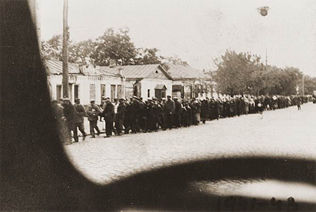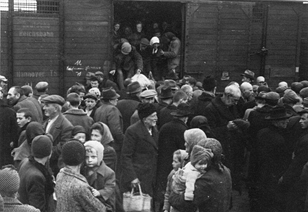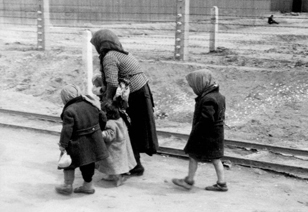What Did the Victims Know?
The Nazis and their Hungarian accomplices tried to deceive their victims until the very last moment. Due to wartime censorship, the press did not report on the destruction of the European Jewish communities before the German occupation; scarce information offered by the Allies was thought to be war propaganda by many. In 1944 the Jews were told that the ghetto was an independent Jewish quarter, the Jewish Council a self-governing body, and that deportation was the transportation of the labour force. Most of the deportees arriving in Auschwitz did not know what fate was awaiting them when the train ran through the "Death Gate" of Birkenau.
Click here to read more about the Holocaust in Hungary.
Nevertheless, fragments of information and stories found their way to many people long before 1944.
 |
Jews are being chased to the site of execution in the Ukraine. The picture was secretly taken by a driver. |
In 1944 the propaganda of the governmental and local authorities was built on two basic lies. On the one hand, it emphasised that the Jews must be removed from the border territories due to military reasons. This myth was one of the favourite points of the extreme right papers,[5] moreover even the paper of the Jewish Council, the Journal of the Jews in Hungary, was compelled to publish it on the 4th of May. Budapest Jews worrying about their relatives living in the north-eastern part of the country read the following in the official Jewish paper: "we were utterly sad to be informed that from the cities and the villages of the border region the Jews are moved into the internal part of the country and they are being concentrated there. A government decree stipulated that in villages and cities in that area Jews are obliged to move into designated streets and blocks".[6] The other element of the government propaganda was the repeated statement that deportees were taken away to work - within Hungary.[7] Different versions circulated about the location: Hortobágy,[8] the Transdanubian Region,[9] Bácska,[10] "Kenyérmező"[11], Rahó.[12] The deceit was effective: most of the deportees realized that they had been deluded when the train left the country, generally at Kassa. "While travelling we still believed that we would be taken to Debrecen or another area in Hungary, until we arrived in Kassa," remembered L. Sz.[13] M. H., a seamstress from Ungvár, also realised the truth when leaving the country: "They told us that we were going to the Transdanubian Region to work but when we arrived at the border we realised in dismay that we were heading towards Poland."[14] Of course, this did not mean that the deportees were aware of what was ahead. The aforementioned L. Sz. thought they would be taken into "some foreign ghetto". He could not even imagine the truth.[15]
There were some, however, who knew what awaited them when they arrived at the "Jewish ramp"
 |
Arrival of Hungarian Jews at the Birkenau ramp |
The Germans wished to avoid the outbreak of panic, therefore they told those asking about their relatives that families would be together again soon. A. F., a teacher from Munkács, wanted to stay with her sick mother, but she was "told that the old people would be taken to the bath on trucks and we would meet them there."[19] "They made us believe that we would meet at the end of the week," remembered P. F.-another version of the Nazi lie. According to the 17-year-old student from Beregszász the deportees deceived themselves: "we comforted each other, saying that we would be taken to work, while they [the elderly relatives] would also be placed in the camp and they would take care of the little children" [20]
Hungarian Jews soon learned the fate of their loved ones. F. L., for example, was informed already in
[21]H. K. was told by relatives from Slovakia, who had been imprisoned in the camp for some time, about what the selection meant.[22] Inmates receiving the Hungarians were generally brutally frank. When K. F., deported from Mátészalka, asked what happened to the old people and the children, the Poles told her "they are being taken to the crematorium to be burned".[23] When the H. sisters asked a Slovakian young woman what was burning and smoking in the far corner of the camp, "she responded that your parents and siblings are there being burnt".[24] Hungarian women who were assigned to the Kanadakommando could see with their own eyes what was going on in the extermination zone.The brutal truth was very hard to accept, and those staying alive frequently did not even believe it. A 15-year-old girl from Munkács remembered the minutes following her arrival: "[The selecting doctor] promised that we would meet our relatives again and he tore me from my mother's hand saying I could walk on my own feet. Although the Poles and the Slovaks told us then that my mother and siblings were gassed, we did not want to believe them and learned of the terrible reality only later."[25] Many could not accept these facts; it was impossible to face that "the old, the weak, young mothers with children were not sent to the other side to transport them into the camp on trucks, but to be murdered with gas". [26]
It occurred that the new arrivals were told that the smoke rising from the chimneys comes from
 |
On the way to the gas chamber |
Sooner or later all of them had to face that their loved ones were murdered. "I already know what happened to them, they also took the path from where there was no way back," said 18-year-old S. L. in 1945.[31]
Footnotes
[1] Protocol 204.
[2] Protocol 2367.
[3] E.g., Protocols 2067, 1344, 129, 594, 748, 2767 were recording the story of survivors, who returned from the Kamenets-Podolsky deportation.
[4] Protocol 123.
[5] See, for example, Magyarság April 30, 1944, p. 13.
[6] "The sky is bright even above narrow rooms". Magyarországi Zsidók Lapja, May 4, 1944.
[7] This was reported by survivors all over the country, for example, from Békásmegyer, Felsővisó, Pestújhely, Kassa, Nagyvárad and Ungvár. See for example Protocols 174, 1743, 2009, 5, 86, 3327, 473, 2641.
[8] For example, Protocols 1358, 520, 99, 1533 and 1351.
[9] For example, Protocols 1359 and 699.
[10] Protocol 1093.
[11] Protocol 1592.
[12] Protocol 3561.
[13] Protocol 114.
[14] Protocol 2385.
[15] Protocol 114.
[16] Protocol 473.
[17] Protocol 2476/B.
[18] Protocol 1530.
[19] Protocol 1015.
[20] Protocol 1414.
[21] Protocol 1001.
[22] Protocol 1484.
[23] Protocol 2587.
[24] Protocol 2534.
[25] Protocol 1615.
[26] Protocol 1329.
[27] Protocol 1533.
[28] Protocols 129 and 2257.
[29] Protocol 2641.
[30] Protocol 2248.
[31] Protocol 1177.

